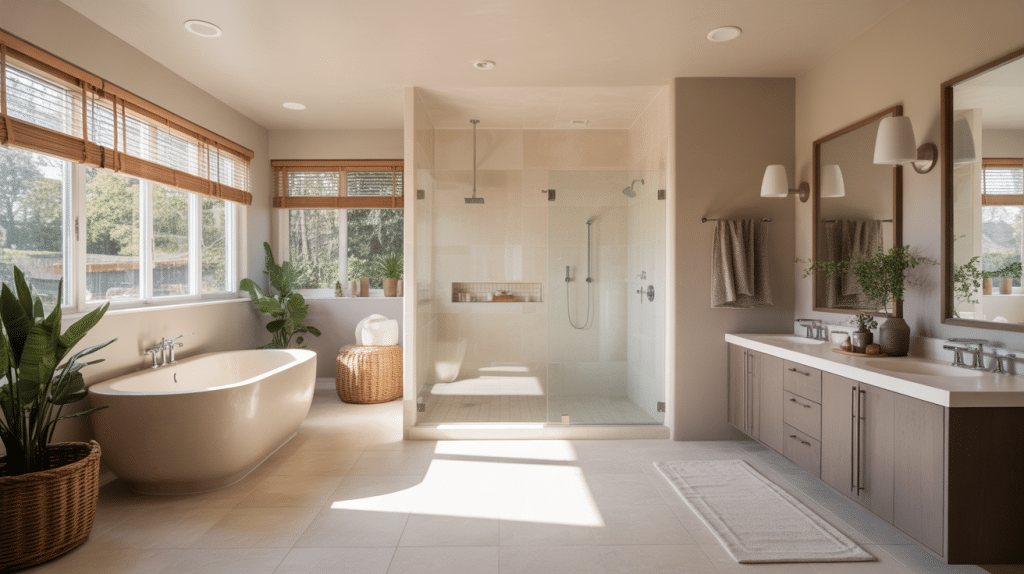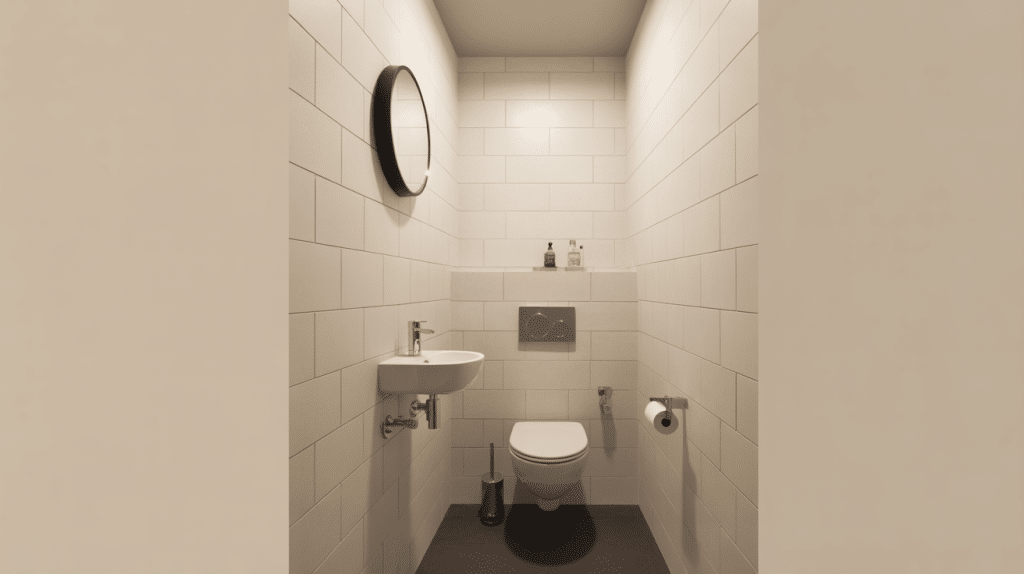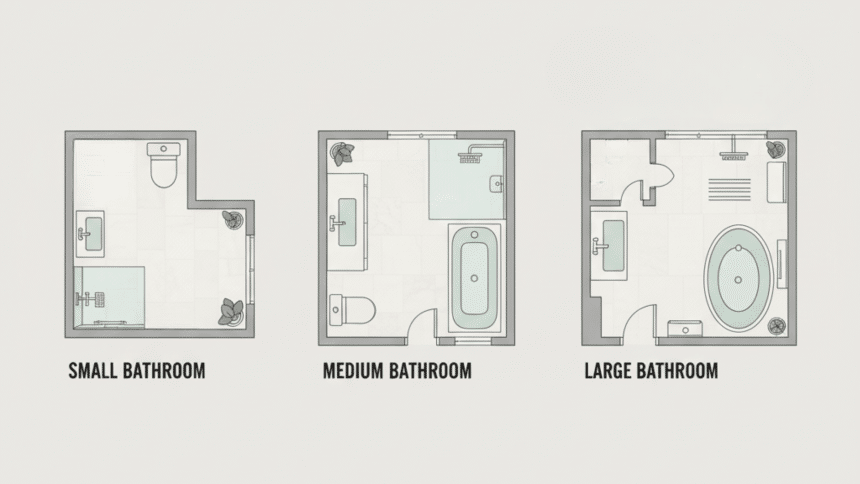Planning a bathroom renovation or building a new home? One of the first questions that pops up is: “How big should my bathroom be?”
It’s a great question, and the answer matters more than you might think.
Knowing typical bathroom dimensions helps me plan spaces wisely. It prevents cramming too many fixtures into a tiny room or wasting valuable square footage.
Designing a cozy powder room for guests or dreaming of a spacious master bathroom retreat, understanding average sizes provides a solid starting point.
Let’s go through everything you need to know about bathroom dimensions. From different bathroom types to common layouts, fixture spacing, and practical selection tips, let’s dive in!
What Is the Average Bathroom Size?
So what exactly counts as an “average” bathroom? In most American homes, a standard full bathroom measures around 36 to 40 square feet. Picture a rectangle that’s roughly 5 feet wide by 8 feet long: that’s your typical full bath.
But here’s the thing: bathroom sizes vary quite a bit. The “average” depends on several factors, including home type, location, budget, and intended use.
A compact city apartment might have smaller bathrooms than a suburban house. A budget-friendly home might feature modest-sized bathrooms, while a luxury home could have bathrooms larger than some people’s bedrooms!
That’s why experts often group bathrooms into three helpful categories: small, medium, and large. These classifications make it easier to plan realistically and set appropriate expectations for projects.
Common Bathroom Size Layouts: Small, Medium, and Large
Bathrooms come in different sizes to fit various needs and spaces. Understanding these three main categories helps in choosing the right layout for any home.
| Size Category | Square Footage | Typical Dimensions | What Fits |
|---|---|---|---|
| Small | 15-40 sq ft | 3’×5′ to 6’×6′ | Toilet + sink, maybe a small shower; perfect for powder rooms |
| Medium | 40-110 sq ft | 7’×7′ or 9’×6′ | Full bath setup: toilet, sink, tub or shower, plus storage |
| Large | 110+ sq ft | 10’×15′ or larger | Double vanities, separate tub and shower, storage, seating area |
Choosing the right size depends on the bathroom’s purpose, available space, and budget. Any size can work beautifully with smart planning.
Sizes by Bathroom Type
Different types of bathrooms serve different purposes, and their sizes reflect that. Let’s look at the most common bathroom types in typical homes.
1. Master or Primary Bathroom

The master bathroom is typically the largest bathroom in the home, connecting directly to the master bedroom.
Standard master bathrooms usually measure around 100 to 120 square feet (such as 10’×10′ or 10’×12′), while luxury versions can reach 150 to 200 square feet or more, providing space for double vanities, soaking tubs, walk-in showers, and spa-like amenities.
2. Full Bathroom

A full bathroom includes three essential fixtures: a sink, toilet, and bathtub or shower combo. This is what most people picture when thinking of a standard bathroom.
Typical dimensions range from 5’×8′ to 6’×10′ (roughly 40 to 60 square feet), offering enough space for everything needed without feeling cramped. These are the workhorses of most homes.
3. Three-Quarter Bathroom

A three-quarter bath contains a sink, toilet, and shower but no bathtub. This setup is popular for guest bathrooms or secondary bathrooms where a shower is sufficient.
These bathrooms typically measure around 26 to 50 square feet, and by skipping the tub, they save considerable space since a shower stall takes up less room than a bathtub.
4. Half Bathroom or Powder Room

A half bathroom includes just two fixtures: a sink and a toilet, with no shower or tub.
These bathrooms are usually located near common areas like the living room or kitchen, designed primarily for guests.
Half bathrooms are the smallest type, typically ranging from 15 to 32 square feet (often just 3’×6′), yet despite their small size, they can make big design statements.
5. Quarter Bathroom

A quarter bathroom is the most minimal bathroom type, containing only one fixture (usually just a toilet or just a sink).
These are rare in homes but sometimes appear in basements, garages, or commercial spaces.
Quarter bathrooms are extremely compact, often measuring just 12 to 15 square feet, roughly the size of a small closet. They can be convenient additions in certain situations.
Fixture Dimensions and Clearances
Understanding the size of individual bathroom fixtures and their required clearances is crucial for planning a functional space.
Building codes mandate specific spacing to ensure comfort and accessibility for daily use.
| Fixture Type | Standard Dimensions | Required Clearances |
|---|---|---|
| Vanity (Single) | 24-48″ wide × 20-21″ deep × 32-36″ high | None required from sides |
| Vanity (Double) | 60″+ wide × 20-21″ deep × 32-36″ high | None required from the sides |
| Toilet | 28-30″ wide × 30″ deep | 15″ from centerline to wall/fixture; 21-24″ clear in front |
| Shower Enclosure | Minimum 32″×32″; comfortable 36″×48″ | 24″ clear space in front |
| Walk-in Shower | 48″×60″ or larger | 30″+ clear space, no door needed |
| Standard Bathtub | 60″ long × 30-32″ wide | 21-30″ clear space on entry side |
| Freestanding Tub | 60-72″ long × 30-40″ wide | 6-12″ clearance on all sides |
These dimensions and clearances aren’t just recommendations. They’re essential for creating a bathroom that’s safe, accessible, and comfortable to use every day.
Always verify your local building codes, as requirements can vary by jurisdiction, and consider future accessibility needs when planning your space.
Tips for Choosing the Right Bathroom Size and Layout
Now that the typical bathroom sizes are clear, how does someone choose what’s right for their home? Here are six practical tips to guide the decision-making process.
- Match size to function: A guest powder room used occasionally doesn’t need to be as large as a master bathroom used twice daily by two people.
- Keep fixtures on one wall for savings: Clustering all fixtures along the same wall reduces plumbing costs significantly since water supply lines and drain pipes are expensive to install across entire rooms.
- Balance size with total costs: Larger bathrooms require more flooring, tile, paint, and fixtures. They also take longer to heat and clean.
- Check local building codes early: Rules vary by location, and what’s allowed in one city might not fly in another.
- Measure everything twice (or three times): Measure the actual space, not just what floor plans show. Account for door swings, windows, and unusual angles.
With these tips in mind, creating a bathroom that balances function, comfort, and budget becomes much more achievable.
Conclusion
Remember that the “average” bathroom is around 36 to 40 square feet, but the ideal size depends on specific needs, budget, and space constraints.
Small bathrooms (15-40 sq ft) work great for powder rooms. Medium bathrooms (40-110 sq ft) offer comfortable full-bath functionality for families.
Large bathrooms (110+ sq ft) provide luxury and spa-like amenities. Master bathrooms typically range from 100 to 120 square feet, while half baths can be as small as 15 to 20 square feet.
Plan for proper spacing around toilets, adequate shower sizes, and enough room to move comfortably.
Ready to start planning a bathroom project? Take some time to measure the existing space, think about how it will be used, and consider which features matter most.
Frequently Asked Questions
What Is the Minimum Size for a Full Bathroom?
Around 36 to 40 square feet (such as 5’×8′) is the minimum comfortable size for a full bathroom with toilet, sink, and tub or shower combo. Anything smaller starts feeling quite cramped.
What’s a Common Size for a Master Bathroom?
A typical master bathroom runs about 100 to 120 square feet (like 10’×10′ or 10’×12′), while luxury versions can reach 150+ square feet with double vanities, separate tub and shower, and spa-like amenities.
How Small Can a Powder Room Be?
A powder room can function well in as little as 15 to 20 square feet (typically 3’×6′ or 4’×5′). Good design doesn’t always require a lot of square footage.

